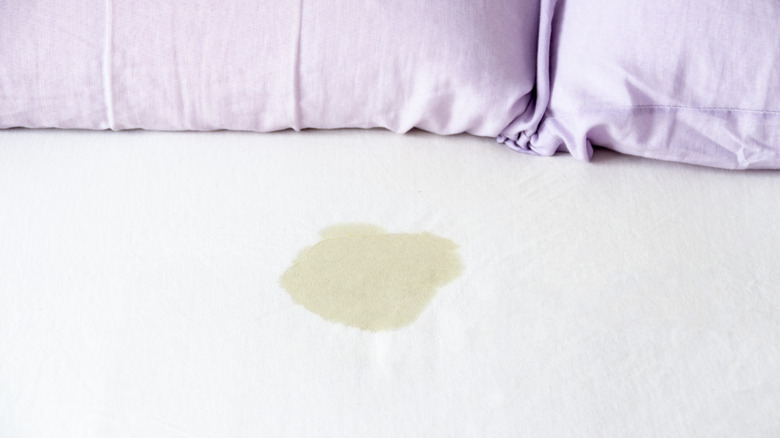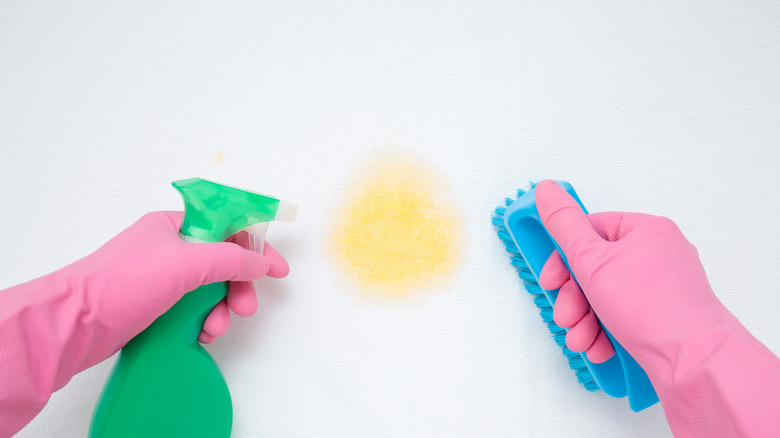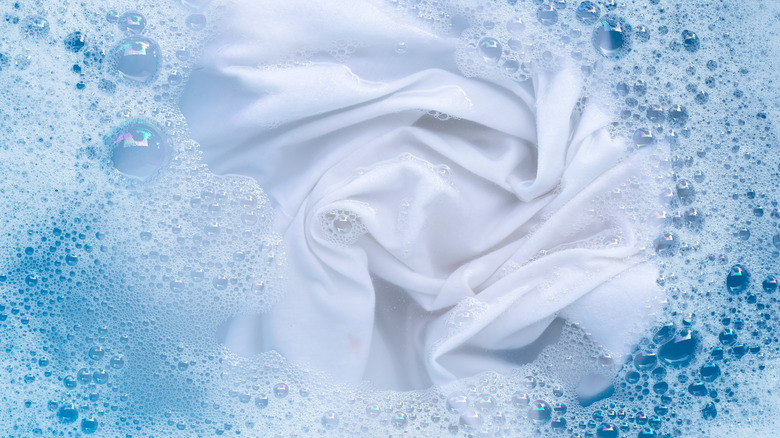The Medicine Cabinet Staple That'll Banish Urine Stains From Fabric
Urine, whether pet or human, can be one of the more challenging organic compounds to remove from fabrics. In some situations, it may create a stain or discoloration on the fabric, whether it's a bed sheet, a piece of clothing, or a towel. That discoloration may also have a lingering scent — one that makes it very hard for you to clean it away with traditional laundering. Hydrogen peroxide, a common substance in many medicine cabinets noted for cleaning wounds, could be exactly what you need to get rid of those urine stains.
Hydrogen peroxide is a type of oxidizing, bleaching agent. That means it works fairly quickly to lift off surface stains and discoloration from fabrics. It's quite an interesting product in that it can be used to support wastewater treatment and even be used in rocket fuels. Most of the variations you find in stores aren't that powerful, but it is effective enough to create a chemical reaction that helps remove organic material and other stains from the surface of fabrics. That is what makes it super helpful with urine.
When using hydrogen peroxide on clothing or other fabrics with dyes, always practice caution. Test in a hidden area to make sure the fabric doesn't fall apart or lose its color (which it can do, especially if mixed with baking soda). For the majority of everyday clothing, sheets, and other non-delicates, testing it will help to ensure it doesn't cause damage.
How hydrogen peroxide can remove urine stains
As an oxidizing agent, hydrogen peroxide has the ability to interact with the bonds that hold stains, including organic materials like urine, on the surface of the fabric. The science behind why this works is rather interesting. Hydrogen peroxide contains an extra oxygen atom that water does not have. When it comes into contact with the organic material, the extra atom breaks into pieces and can dismantle other compounds by attracting their electrons — the same phenomenon that occurs when hydrogen peroxide is poured onto an open wound — which in turn creates a loosening of the dirt on the fabric. In this case, it's urine.
This oxidation process also works to kill the bacteria that may be lingering, which is often why there's a urine scent present alongside the stain. That bacteria can linger even when the fabric is dry. However, the activation of hydrogen peroxide breaks down the cell walls of the bacteria present, eliminating it and, as a result, allowing the scent to simply be washed away.
By contrast, just washing the fabric item in laundry soap doesn't do anything to break down that bond, and that makes it much harder for the stain to lift out. However, the hydrogen peroxide helps to give the stain just enough give to allow the organic compounds to clean away when you launder or rinse it.
How to use hydrogen peroxide to clean urine
For oxidation to occur, there has to be direct contact between the hydrogen peroxide and the urine and bacteria present on the fabric. As noted, in high concentrations, it can certainly cause discoloration and have a bleaching effect on the fabric, so testing a small area first is ideal.
The process from there is rather simple. Place a teaspoon of 3% hydrogen peroxide (one of the more common forms available in drug stores) on the stain directly. Allow it to saturate into the stain and cover the entire area of discoloration. Let it soak like this for several minutes or even longer without allowing it to dry out. Once you do this, wash the fabric as you normally would in the washing machine.
Another helpful tip is to use hydrogen peroxide to clean laundry routinely. If you have a person in the family who may have a few accidents every now and then and uses white sheets, you can add hydrogen peroxide directly to a load of laundry on a routine basis. It will help to lift off the material present. That's a great way to treat all of your whites, just in case there's a problem you miss.


